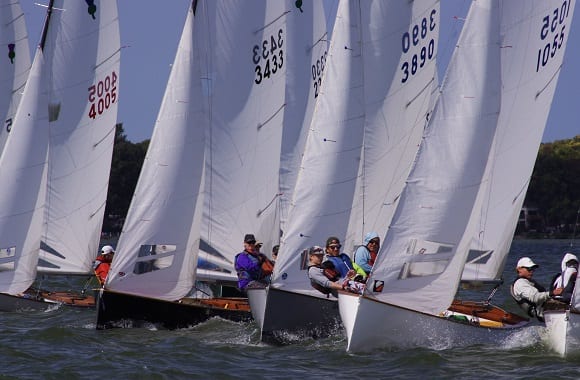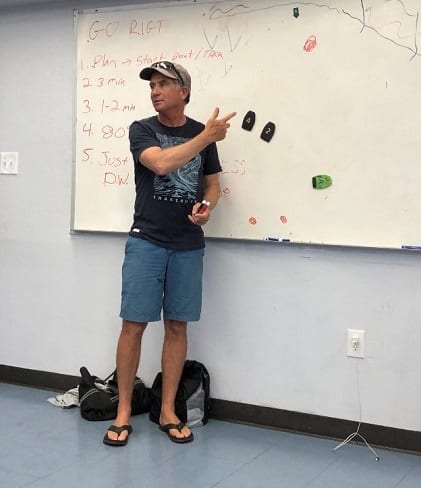By Tom Hubbell, Thistle Class President and Past President, US Sailing
As Malcom Gladwell in The Tipping Point informs us, it takes a trio of talented people to make good things happen, the salesman, the connector, and the maven. The salesman is the charismatic persuader who tends to make everyone want to adopt his perspective and interest. The connectors are the people in a community who know “everyone” and are in the habit of making introductions all around. And the maven is the information specialist, the one who accumulates and provides expert knowledge to the rest of us.

Before I share the secrets of the Thistle Class, consider my experiences below. These are all related to thriving as a class.
As a teenager in a non-sailing family, I was lucky to have access to the X-Boat that my Sea Scout Ship owned on a lake near St. Louis. Being a youth sailor came with last minute barriers: arranging transportation, having money, and re-confirming teammates, e.g., their moms would not let them go. At 26, as a new owner of an old Thistle in Kansas City, I heard stories about Roger Brett. He inspired Thistle fleet growth in Kansas City in the 60s. Brett later served on the Executive Committee of USYRU (US Sailing). In Missouri and later in Ohio, we had local fleet parties in the off-season featuring presentations by notable sailors like Bruce Goldsmith, Larry Klein, and Greg Fisher. Knowing that one of these notables would be at the party guaranteed a good turnout, and it was fun to meet the top sailors. I always learned something and reinforced a few things I thought I knew already.
After moving to central Ohio in 1978, it seemed that almost every sailor I met had started out sailing at Hoover Sailing Club with Clyde Findley, a salesman of the “sizzle” to many newbies. At that time, we became close with Bob White, a Thistle National Champion, and he critiqued every race, if not every tack, for the next several years. Our boat’s performance improved dramatically, and we have a lasting friendship.
Ed and Katie Duckworth took us by the arm at the first cocktail party at our first Midwinters in 1980 and introduced us to every sailor at the regatta, each one by name. In the ‘80’s, right before the Midwinters, Ed also put together a weekend of presentations by experts along with on-the-water drills.
In my examples above, you can see the salesmen: Roger and Clyde. The mavens: Bruce, Larry, Greg, and Bob. The connectors: Ed and Katie.
Learning a new skill inevitably includes failures and disappointment. Youth itself presents special problems for a sailor. Regatta formats can be inviting, or they can be demoralizing. With that bit of personal background on making good things happen and what we have learned from others at many US Sailing seminars and meetings, there really is no big secret about what works to build and sustain one design class racing.

Here is the formula and 10 things that the Thistle Class Association is doing right:
- Continuing to learn and improve skills makes sailing fun, brings people together, and keeps people in the game.
- Sharing skills and insights is everyone’s responsibility and everyone adopts that attitude
- Learning sessions on shore and on the water (with the maven) bring people together, especially connecting neophytes with seasoned sailors
- Tactful or kind coaching on-board takes the mystery out of three crucial elements that just cannot be adequately put into words: not over-steering, sail trim, boat balance
- Developing skills for crewing the boat is just as important as skippering skills
- Pulling the fleet and the expert resources together, connecting everyone in person, by email and by phone is the job of the organizer (the connector)
For 25 years, the Thistle Class has been delivering Coach-TCA. This coaching program wraps around the week-long experience of Thistle Midwinters East in St. Petersburg, Florida. The idea grew from Greg Fisher’s model of pre- and post-race seminars and debriefing sessions. His collaboration and expertise was the critical ingredient that created and fueled many years of Coach-TCA. The week of sessions typically includes:
- Personalized onshore boat tune-up
- Daily 20-minute morning sessions about lessons of the previous day and weather today
- Daily organized discussions or post-race analyses, videos, or demonstrations (such as how to jibe the pole demonstrated in a boat in the parking lot or a walk-through of using the compass tactically)
- On-board coaching – weather and time permitting, the goal of one 30-minute session with a top-of-the-fleet sailor getting in the boat (not during a race.) This is the most difficult to schedule but also the most rewarding aspect according to participants. [i]
It takes one connector to pull this together with at least one maven, usually a sailmaker or stand-out sailor for the talks, and several prominent sailors as salesmen, promoters for the concept. For example, a note to the listserv, “Participating in Coach-TCA is a good way for competent home-fleet sailors and for experienced sailors who need a refresher to get up to speed for the more challenging regattas.” Some years we have provided a notebook with the course outline, or the book that grew out of this project.[i]
In the first two years of offering Coach-TCA, attendance at the midwinter regatta grew from the low 30s to 55 boats. We have usually charged $30 per boat as a donation for materials and a round at the yacht club bar. We think paying money helps cement engagement in learning. The experts willingly donate their time.
For many years we have used a similar seminar/debrief model at nationals, sometimes with morning talks and often with a moderated after-racing debriefing by the top finishers. We impose “rules” preventing them from wandering into trivial adjustments and minutiae. It is also not helpful for them to explain their success as “we were fast.” We want to know how they went fast, if true. A moderator can really help connect the speakers with the interests of the audience. There is typically a lot of give and take among the top contenders during these sessions. The contrasting views can be enlightening, too. Even at the nationals, the top sailors are willing to share their thinking and expertise during these sessions and informally in the boat park. And it is the norm. Many fleets have successfully taken home this concept of organized sharing of expertise and the accompanying social engagement because it works.
We cannot ignore the fact that while all this informative talking is going on, something else is happening; people are connecting and forming friendships. That connection/engagement is the glue that makes participation and membership in the Thistle last whether they actually see improvement in their sailing results or not. Someone suggested that the whole fleet improves together, making individual gains less apparent. That is okay too.
2. Being on shore together is the most important element because it is the friendly relationships that matter.[ii]
-
- We know that people sail Thistles to be with their friends afloat and ashore; the boat is (surprisingly) secondary.[iii]
- Partnering veteran boat teams with neophytes at regattas fosters both the social and the sharing of knowledge aspects.
- Having a fleet spark plug, the salesman, is essential; this is a person who regularly pulls new players into the game and makes sure their early experiences are positive.
- De-emphasizing scores reduces pressure on the less-experienced sailors while rewarding improvement and recognizing crew individually is a successful strategy.
3. We are Safety Conscious. Have an emergency plan including boat check in and check out and a rational decision process about storms and high wind. (And we have a strict policy on masks and distancing during the pandemic.)
4. We lowered the barriers for youth participation. We began lowering the hurdles for youth sailors, back in the 80s. We eventually got rid of all the rules that might impede youth except ‘show up with a legal boat.’ Lately, youth skippers attending the major regattas can get reimbursed for their registration fee from our Thistle Growth and Promotion Fund. Many local regattas have eliminated or drastically reduce the fee for youth skippers.
5. We are green. With Sailors for the Sea, (SFS) we have conducted “Clean Regattas” at the Silver level in 2012 for the Great Lakes Championship and for the 2017 Nationals, both at Chautauqua Lake. We are now working with SFS to define and pilot a new clean one-design class program.
6. Regatta and fleet racing formats – we are raising awareness of these ideas:
-
- Having shorter races helps prevent burnout, especially for those struggling in the back of the fleet
- Only in ideal conditions, planning for a higher number of races increases the possibility of a boat having a good leg or race
- Creating a camping option at regattas whenever possible
- Getting together after racing, always
7. Communication always matters.
-
- We are holding periodic town halls where class officers hear concerns and ideas of age 40-and-under sailors.
- We are committed to having workable communication tools for the class including a lively email listserv, website resources, social media posting by active members, and a full-color class magazine, e.g., The Bagpipe, in print and online. People love to see their names and pictures in print. This year, with class survey data in hand, the TCA has re-invested in our website, listserv, and social media efforts.
8. Funding: Our class wants to grow and endure. With little effort, we have raised over $50,000 of donations in three years to support growth and promotion and extend our operating budget.
9. Mixed gender teams are the norm in Thistles and are key to engaging families and growing the class. The magic of a three-person boat is that the ideal racing crew weight often means that at least one woman is on the team. When women are essential to an activity, men and boys are more likely to participate. And we know that women excel at making the social aspects better, building community.
10. Level playing field: We hardly ever allow changes in the one design aspect of the boat. Boat #1 is still being raced competitively at 75 years old. We also have a new builder to follow the legacy of our long-time builder, Doug Laber.
An important challenge, that remains inadequately solved, is predictable reliable childcare for the little ones not yet sailing while the parents are on the water. It requires a secure indoor and outdoor space which few clubs offer now and a cadre of able adult volunteers. A reproducible solution to this challenge would significantly increase the number of young couples sailing.
Please visit One Design Central for more one design sailing resources and information.

[1] In the feedback after each week we have received this comment many times, ‘Coach-TCA is the reason I came to Midwinters, and the coach-in-the-boat was the best part.’
[1] Sailboat Racing with Greg Fisher, by Tom Hubbell
[1] Better Together, Robert Putnam
[1] Survey of the Thistle Class, 2019

